
[Source:
Nick Catford]
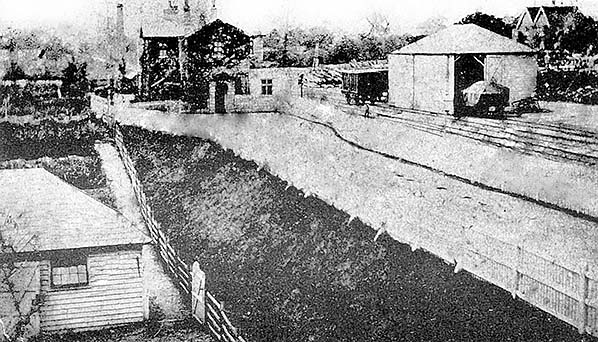 The first East Grinstead Station seen looking west in 1860. Compare this picture with the picture of the original station building which is still standing 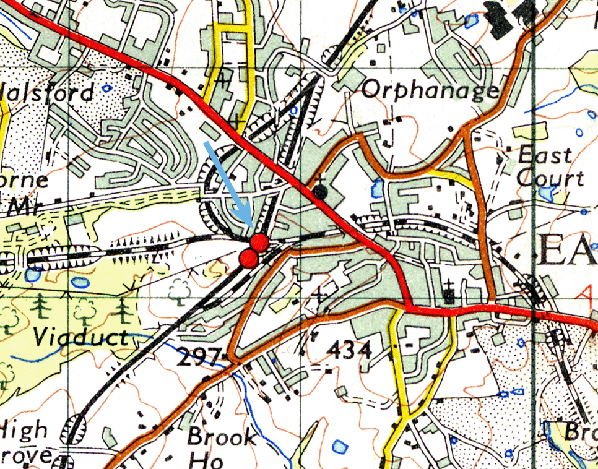 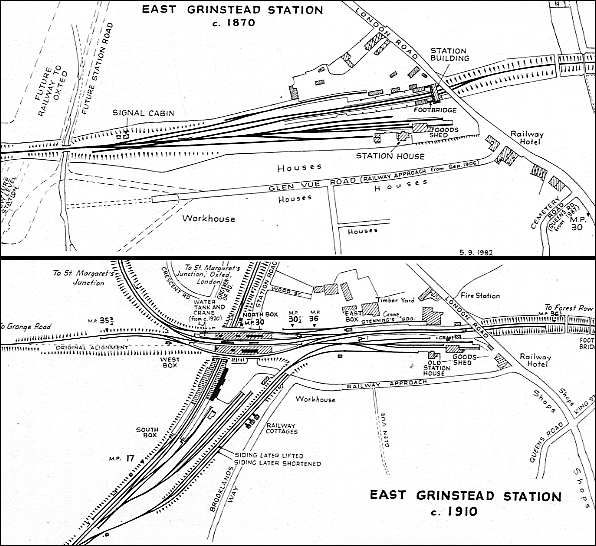
The top map shows the layout of East Grinstead Station in 1870 and the bottom map shows the layout in 1910 after the station was re-sited to the west.
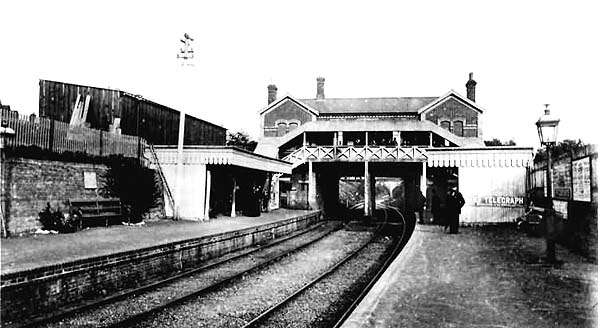 The second East Grinstead station on what is thought to be opening day, 1 October 1866, facing east towards Forest Row. The street level building was accessed from, but was not on, London Road which crossed the railway on a skew bridge and this explains the almost tunnel-like bridge beneath and just beyond the building. The scene is generally rather untidy and quite why steps down to each platform were not incorporated into the station building, thereby dispensing with the need for a footbridge, is not known. The brick arch bridge in the background carried a footpath over the railway and a little further on, out of view around the curve, is the short 78 yard tunnel, known as East Grinstead No. 1 Tunnel, taking the railway beneath College Lane. As can be seen, the station was gas lit from the outset. East Grinstead gasworks was situated on Moat Road, to the north of the station, 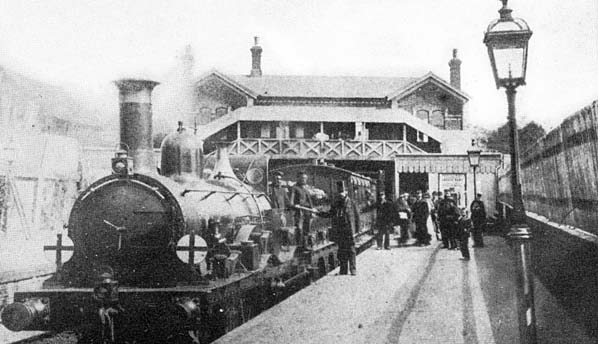 The second East Grinstead station on what is thought to be opening day, 1 October 1866, facing east towards Forest Row. To avoid any confusion it is perhaps worth pointing out that this station would in due course be replaced by what became East Grinstead High Level further west, it being a matter of convenience to include this and the original terminus on the Disused Stations High Level pages. It would appear the locomotive crew is being handed the train staff by the stationmaster, suggesting the inaugural westbound train, although this procedure would have been carried out with all trains. The locomotive is a LB&SCR 2-4-0 and while its identity is by no means confirmed it is possibly No. 40, built in 1854 by Messrs. Sharp, Stewart and Company. The LB&SCR used a bewildering array of headcodes, with plain and marked discs, such as the crossed discs seen here, along with lamps. Those codes varied in accordance with daylight and after-dark hours, also whether or not the crew were in possession of a staff or ticket. Not much headcode information for the pre 1881 period is known although it is fairly obvious the code seen here was for Tunbridge Wells - Three Bridges or vice versa including points in between such as East Grinstead - Three Bridges. 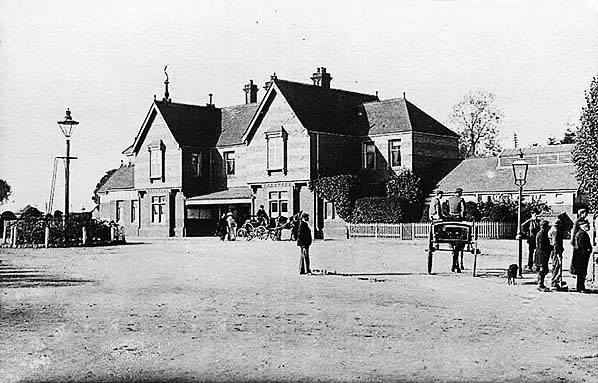 The uncluttered forecourt area in this undated scene is from the late nineteenth century. Of note is the tall gas light on the left with an access ladder not dissimilar to those found attached to signals. The light is set in small enclosed garden. Photo from John Mann collection 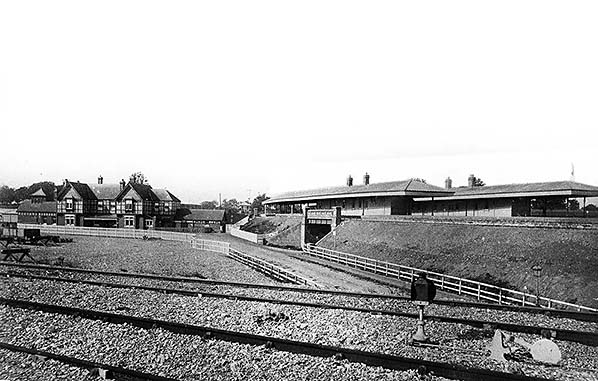 An interesting and good quality photograph taken in 1882, the year before the High Level section of the station opened. At this time the second station on the line from Three Bridges was in use. The tracks in the foreground were newly laid and connected to the Culver Junction and Lewes line. The tracks crossed Station Approach, running diagonally across the picture and once known as Glen Vue Road, on a bridge. Later, just one track crossed the bridge and the remainder, there were three in total, terminated on it. These were themselves later truncated, leaving just a single track crossing what had been reduced to a single span bridge. Note the ballast covering the sleepers; this was standard practice at the time but caused maintenance issues and was outlawed sometime around 1919. At centre far left can be seen further sidings, part of the goods yard, with at least one wagon present. Note the enclosed structures on the High Level platforms; by the time this part of the station closed these structures had been largely removed.
Photo from John Mann collection 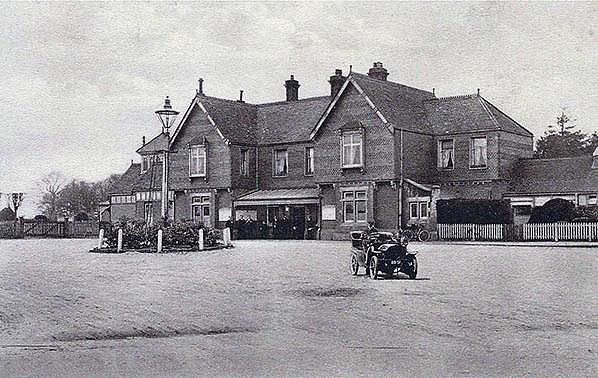
Another view of the forecourt, this time a little later. The motor car registration number dates from December 1903 so this would be the earliest date. Apart from the staff line-up, differences to the earlier scene include the appearance of more posterboards and a tidying up of the bushes at the north end of the building.
Photo from John Mann collection 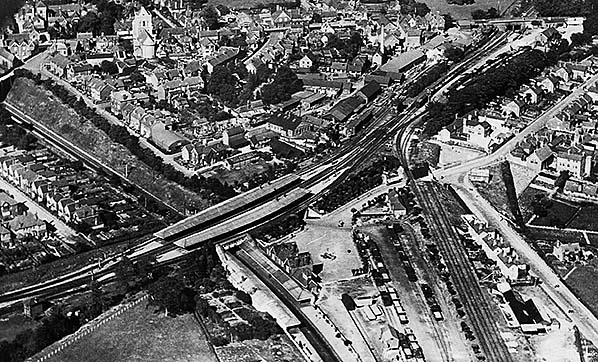
This view, believed to date from the 1920s, provides a good insight of East Grinstead's railways as they were at the time including the High and Low Level stations. At bottom centre is the line to Culver Junction, part of which is a now the heritage Bluebell Railway while at bottom left is the line towards Three Bridges and the start of St Margaret's Curve which connected the High Level station to the Oxted line. Also at bottom left can be seen East Grinstead West signal box, this controlled sections to Rowfant and St Margaret's Junction. The Low Level goods yard is visible towards lower right and there was of course a connection, out of view here, with the Culver Junction (Lewes) line. Interestingly the bridge over Railway Approach has been reduced to a single track span; the other two sidings, centre and right of the three, had once extended a few yards further north to terminate on the bridge. At top right are the sites of the original terminus and second stations plus London Road bridge, just ahead of which had stood the building for the second station. The original station house, while difficult to discern, stands camera side of the goods shed. Today it is the only surviving building associated with the original station. Click here for a larger version.
Photo from John Mann collection 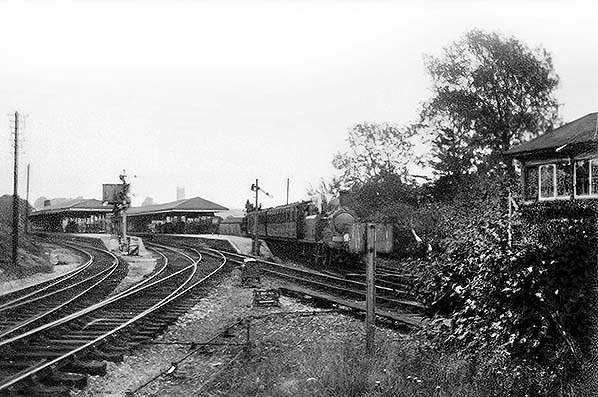 An undated view looking due east across High Level with what appears to be a Stroudley Class E1 departing with a train for Three Bridges. The scene is very difficult to date with any accuracy but is perhaps c.1930. Close scrutiny shows the locomotive carries a single word on its tank and this could only be "Southern", so the period is certainly post 1923. The E1 Class began life in 1874 as the E Class and was intended primarily for goods and shunting work, although use on branch passenger services, such as here, was not uncommon. Four of the class ended up on the Isle of Wight. The final examples at work for British Railways bowed out in 1961 but one example had been sold to a colliery in 1927 and continued to work until 1963. It has survived to be the sole example in preservation.
Photo from John Mann collection 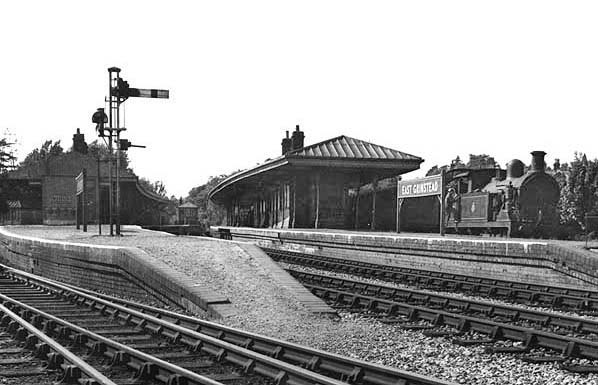 An unidentified H Class 0-4-4T stands at Platform 6. Close examination reveals she wears the early BR device, often lampooned as 'The Cycling Lion', which was replaced from 1956 as and when locomotives visited the paint shops. She is coupled to a 'Birdcage' coaching stock set. Both observations suggest this photograph dates from fairly early in the BR period. The train being at Platform 6 implies the train is an Oxted - Tunbridge Wells West service. There were a limited number of such services during the peak hours and they ran semi fast, for example omitting Lingfield, Dormans, Hartfield and Withyham.
Photo from John Mann collection 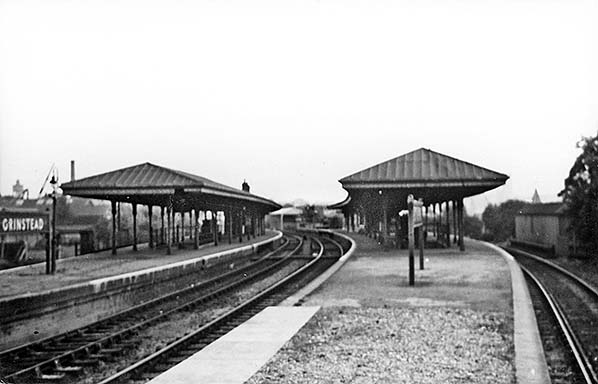
East Grinstead station looking east from platforms 3/4 in October 1953
Photo from John Mann collection 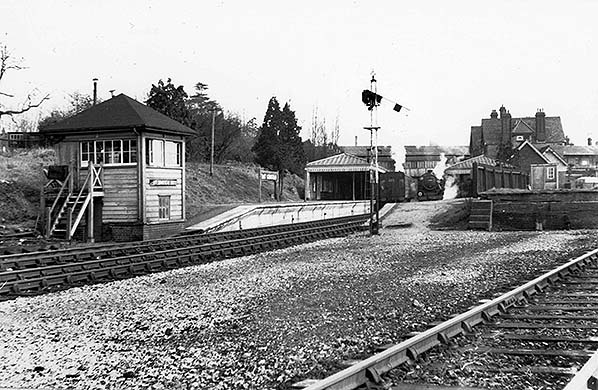 The Low Level platforms facing north in March 1954. At centre right is the station building with the High Level platforms in the background. At extreme right background part of the High Level Platform 3 can be seen; this spot gave a good view over the Low Level goods yard, station forecourt and the line towards Kingscote over Imberhorne Viaduct. In the right foreground is the connecting spur between Low and High Level goods yards. The dock on the right was served by the siding at right foreground and at one time a further siding served the end of the dock, running through the open space in the centre of the picture. The connecting line between Low and High Level goods yards is out of view to the right. East Grinstead South signal box stands on the left. On 15 September 1958 it became East Grinstead C 'box, and was given a green enamel nameboard stating simply 'East Grinstead'. The 'box was abolished in 1987 as part of the resignalling associated with electrification of the line, by which time it bore a corporate black and white nameboard. Electrification, incidentally, arrived some forty-five years late. The Southern Railway had planned large scale electrification which included the line to East Grinstead Low Level and thence to Haywards Heath via Ardingly. The Depression and then the Second World War ensured the only section of this route to receive the third rail was Copyhold Junction (Haywards Heath) to Horsted Keynes. With electrification to East Grinstead in 1987 the section south as far as Imberhorne Viaduct was also electrified as it was used as a siding and this was the only part of the 'Bluebell' line to ever see the third rail (Ardingly branch electric trains used a platform at Horsted Keynes which was not part of the 'main' line to Culver Junction). In this scene one the LMS designed but Brighton built Fairburn tanks is signalled away from the Down platform. It has come from Oxted and will proceed to Culver Junction and Lewes, possibly beyond. The 'Bluebell' line was to close in 1955 and the story of what happened subsequently needs no explanation here. In the Up platform is 3-set No. 633. Known by some as 'Trio Sets', these were 'Birdcage' sets with a 'Birdcage' brake at each end. For some reason a few of these sets had the guard's 'Birdcage' lookout removed from one end and No. 633 was among them. The 'de-birdcaged' vehicle is that nearest the camera, it being Brake Third No. S3470S. This vehicle was withdrawn in October 1956 but the other two, Composite Lavatory S5499S and Brake Third Lavatory S3543S, were converted for Push-Pull operation by which time S3543S had also lost its 'Birdcage'. The conversion occurred during 1957, quite late for these becoming-rather-ancient ex-SE&CR vehicles. Among the pictures of the High Level platforms are a few showing trains comprising some of these conversions to 2-car Push-Pull sets. They were ultimately replaced by conversions of ex main line Maunsell sets, these in turn being ultimately largely replaced by Diesel Electric Multiple-Units. If the photographer of this 1954 scene were able to stand on the same spot today, he would be more or less standing at the northern end of the heritage Bluebell Railway's platform.
Photo by RM Casserley 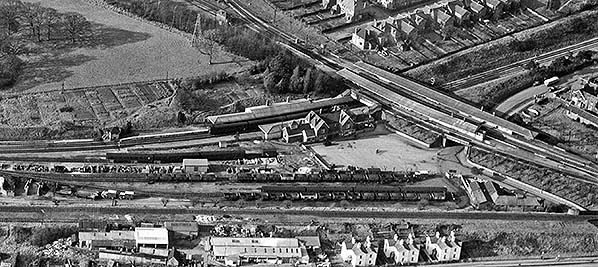
One of two views over the station complex taken in 1954, this one facing north-west. The station itself needs no description except to note the canopy length of the Low Level Up platform compared to that of the Down platform. The Up platform would have been the busier of the two at the Low Level. Such provision at High Level was more generous and until closure it was by far the busier part of the station. Low Level was something of a quiet backwater until 1967, even before the line to Horsted Keynes and Culver Junction closed. This is the line seen sneaking away at left centre. The Low Level signal box can also be seen left of centre. This was South Box and in accordance with the renaming of the High Level boxes to 'A' and 'B' on 15 September 1958 it became 'C' Box. With the closure of High Level it reverted to 'East Grinstead'. South Box dated from 1 August 1882 and had a Saxby & Farmer 15-lever frame. It survived until 18 July 1987. As a point of interest, there was also a North Box which dated from 1883 and had a Saxby & Farmer 12-lever frame. It was abolished by the Southern Railway on 9 October 1928. Further towards the bottom of the picture is the Low Level goods yard which appears to be predominantly occupied by coal wagons although there are two rakes of coaching stock present. Also visible is the connection to the High Level goods yard, with one of the tracks, which previously crossed the bridge, bottom right, now truncated. At top left of centre behind the pylon, the belt of trees marks the course of the original line from Three Bridges as it approached East Grinstead's original terminus and second station. The general area of the Low Level yard is now, 2023, largely occupied by Sainsbury's and its car park. The modern East Grinstead station building is a little further south from the original seen here and the heritage Bluebell Railway's platform is located at extreme left. Click here fore a larger version.
Photo from Britain From Above, reproduced with permission 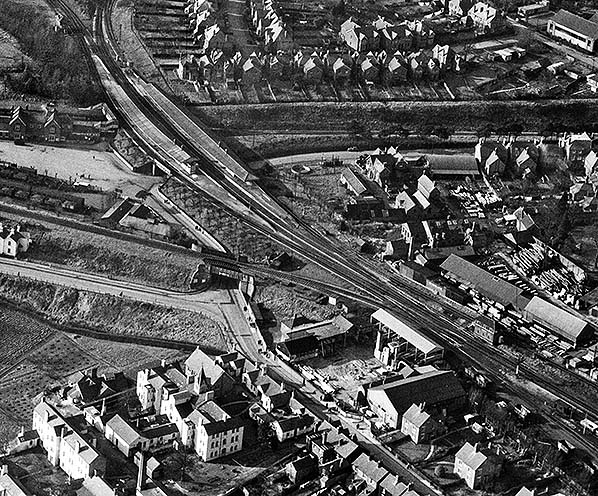 One of two views over the station complex taken in 1954, this one facing west north west. By the 1950s there were plenty of motor vehicles on the roads yet in both 1954 aerial views very few can be seen; this and the lay of shadows suggests the photographs were taken on a evening. Some pedestrians can be seen but in those days, while some people went out to, say, a cinema during an evening especially on Saturdays, most people went home at the end of the working day and remained at home until the following morning. Crossing Station Approach bridge is the connection link between the Low and High Level yards. To the right of the bridge are stacks of sleepers and it would appear track lifting is ongoing, which would leave just a single track crossing the bridge. In due course the bridge itself would be reduced to single track span. Photographs of the East signal box are not common, although it can be seen in the background of some photographs taken from the High Level platforms. This view does at least show its front elevation which makes clear it was the largest of all the 'boxes at East Grinstead. With its 43-lever Saxby & Farmer frame, it remained in use until the line closed. To the north of the signal box is a timber yard which was served by a siding visible here running behind the 'box. Facing the 'box. i.e. on the south side of the railway is another timber yard. Both were still in operation at the time the railway closed but no longer exist. The clutter of buildings at bottom left was the East Grinstead Union Workhouse, dating from 1859. The 'T' shaped building in the centre of the complex was the main block while the building to its south was a hospital of sorts for people with infectious diseases. The complex also had a chapel and a school. The site of the workhouse at East Grinstead is acknowledged by a path named 'Institute Walk' which serves a modern housing development and various commercial premises. Click here fore a larger version.
Photo from Britain From Above, reproduced with permission 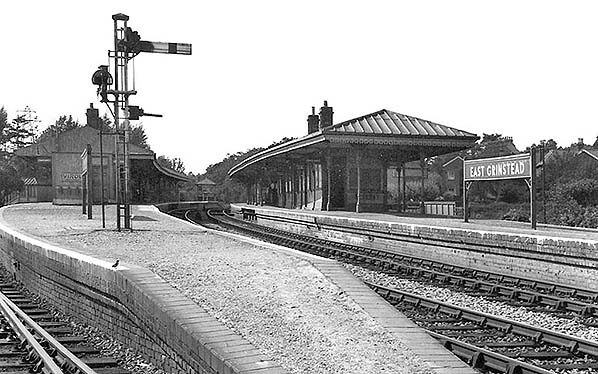
East Grinstead station looking west during the 1950s. Platforms are from left to right 3, 4, 5 and 6. Beyond the platforms St Margaret's Curve and the Oxted line is to the right with the Three Bridges line straight ahead. East Grinstead West signal box is seen in the distance.
Photo from John Mann collection 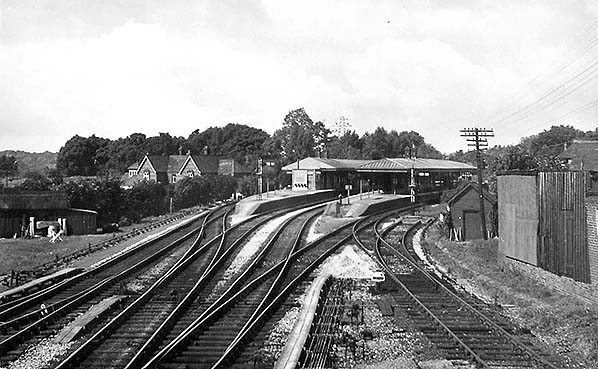
Looking east from the West signal box towards the high level platforms c1950s. Platforms are from left to right 3/4 and 5/6. The entrance building is seen to the left.
Photo from John Mann collection 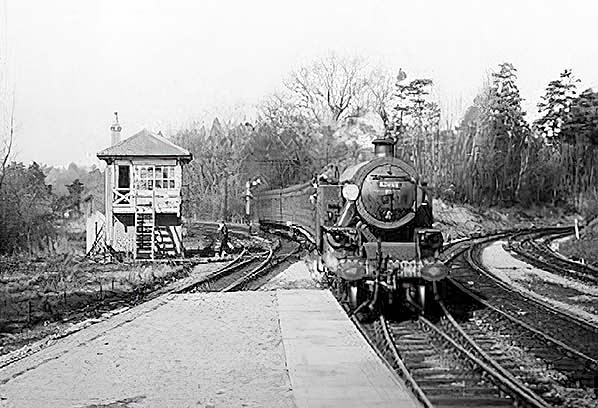 Sometime in the 1950s a Fairburn 2-6-4T arrives with a train from Three Bridges. Its number is unfortunately illegible, otherwise it would have been possible to narrow down the year. British Railways had built a batch of these LMS-designed locomotives for use on the Southern Region but all were transferred away during the 1950s in exchange for BR Standard 2-6-4Ts, with the last Fairburn leaving the Southern Region in 1959. The train is passing East Grinstead West signal box. This had a Saxby & Farmer 27-lever frame (East 'box had a 43-lever frame of the same origin). It will be noticed there is just a Home signal in the background, not the bracket signal visible in later views. On 15 September 1958 West 'box, which sat on the pre 1883 track alignment, was renamed 'A Box' and East was renamed 'B Box'. It is not unreasonable to assume changes to signalling occurred at the same time.
Photo from John Mann collection 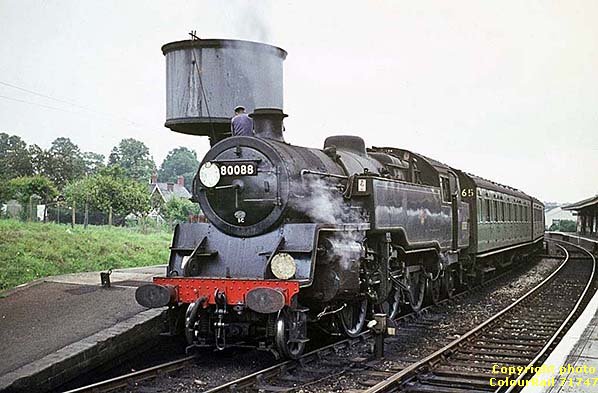
In March 19567 a BR Standard 4MT 2-6-4T No. 80088 takes on water at Platform 5. Upon departure this train will proceed to St Margaret's Junction and thence onto the Oxted line. The 'SC' on the smokebox door refers to 'Self Cleaning' which in simple terms meant ash in the smokebox was pulverised and then ejected from the chimney. New ex-Brighton Works in July 1954, she went new to the London Midland Region and would have had four lamp/disc brackets with the additional two for Southern requirements being fitted when transferred south. Class members intended for the Southern Region at the outset left works complete with six brackets. No. 80088 was withdrawn in June 1965 and did not survive into preservation.
Copyright photo from ColourRail
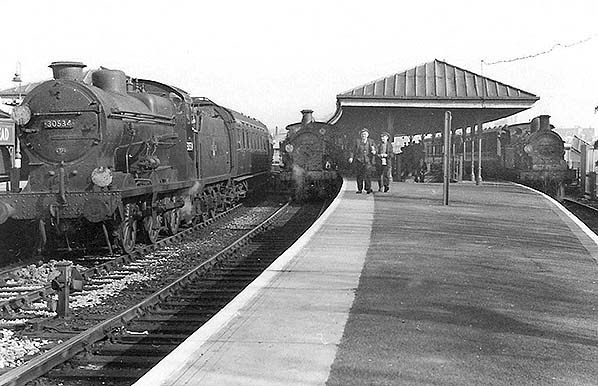
An ostensibly busy scene photographed sometime between 1956 and 1962, 'ostensibly' because human activity appears to be mainly, if not entirely, in the form of staff. Maunsell Q Class No. 30534 on the left carries the 1956 BR device on her tender. Withdrawn from Brighton shed in December 1962, at the time of this photograph she was allocated to Norwood Junction. She is presumably working a Tunbridge Wells West - Victoria service. Also present are two H Class locomotives on local Push-Pull workings; left, Three Bridges - Tunbridge Wells West and right, same but in the opposite direction.
Photo
from John Mann collection
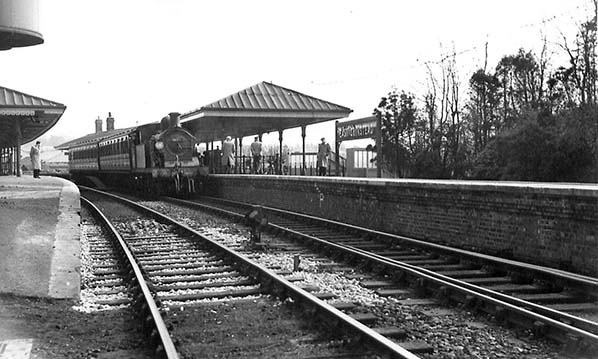 On an unknown date during the British Railways period an unidentified H Class 0-4-4T pauses at East Grinstead. One gets the feeling the raincoated gentlemen apparently casually standing around are railway enthusiasts. Perhaps, therefore, the occasion was the final closure of the East Grinstead Low Level - Culver Junction line in March 1958. Directly ahead of the camera the upper landings of the Low Level station's footbridge can be seen. On an unknown date during the British Railways period an unidentified H Class 0-4-4T pauses at East Grinstead. One gets the feeling the raincoated gentlemen apparently casually standing around are railway enthusiasts. Perhaps, therefore, the occasion was the final closure of the East Grinstead Low Level - Culver Junction line in March 1958. Directly ahead of the camera the upper landings of the Low Level station's footbridge can be seen.Photo from John Mann collection 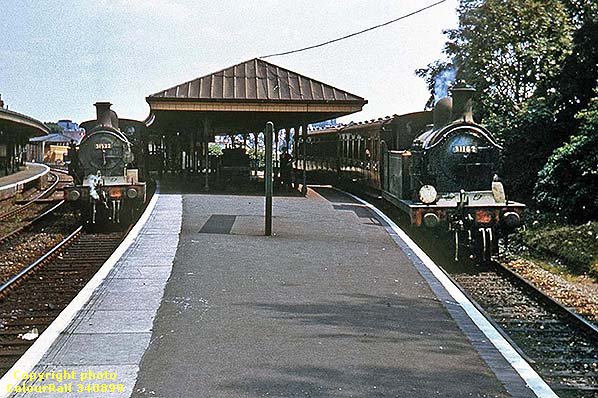 During March 1959 H Class locomotives Nos. 31522 and 31162 pause at East Grinstead High Level. The headcode displayed by No. 31162 had signified Tunbridge Wells West - Oxted via East Grinstead but it was not possible to access the Oxted line from this platform. Alterations to these headcodes occurred from time to time going right back to Pre-Grouping days and British Railways made further changes during the 1958 - 1961 period. In this photograph, therefore, the meaning of both headcodes is unclear.
Copyright photo from ColourRail 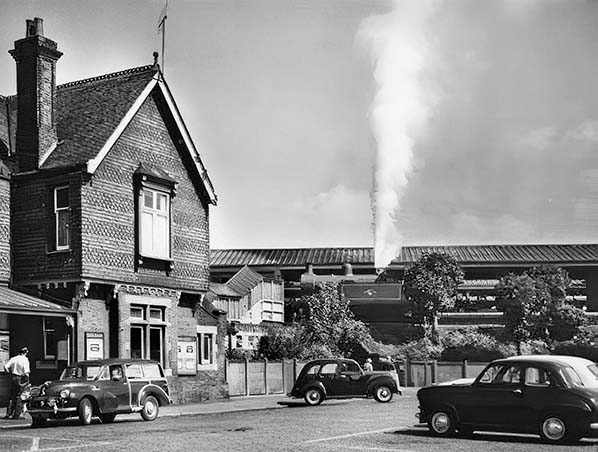 Viewed from the forecourt, with the station building on the left, a Class H 0-4-4T sits in the High Level Platform 3 on 4 July 1959. The decoration of the station building was typical of Lewes & East Grinstead Railway buildings but perhaps not quite to everybody's taste, being bordering upon over-elaborate. This building was demolished during 1970 - 1971, to be replaced by one of the ghastly CLASP structures sited a little further south. The present (2023) station building dates from 2013. Potential competition lurks on the forecourt in the form of, left to right, a Morris Minor Traveller, what appears to be a Ford Prefect E493A and an Austin A35 plus one other unidentified vehicle. The H Class locomotive's safety valves are blowing off and while the noise would have been very loud nobody is taking any notice, such was the familiarity with steam locomotives at the time.
Photo from Ted Burgess 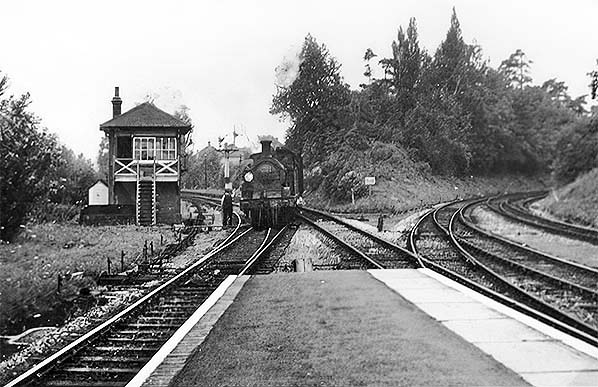
Sometime in the 1950s a Fairburn 2-6-4T arrives with a train from Three Bridges. Its number is unfortunately illegible, otherwise it would have been possible to narrow down the year. British Railways had built a batch of these LMS-designed locomotives for use on the Southern Region but all were transferred away during the 1950s in exchange for BR Standard 2-6-4Ts, with the last Fairburn leaving the Southern Region in 1959. The train is passing East Grinstead West signal box. This had a Saxby & Farmer 27-lever frame (East 'box had a 43-lever frame of the same origin). It will be noticed there is just a Home signal in the background, not the bracket signal visible in later views. On 15 September 1958 West 'box, which sat on the pre 1883 track alignment, was renamed 'A Box' and East was renamed 'B Box'. It is not unreasonable to assume changes to signalling occurred at the same time.
Photo
from John Mann collection
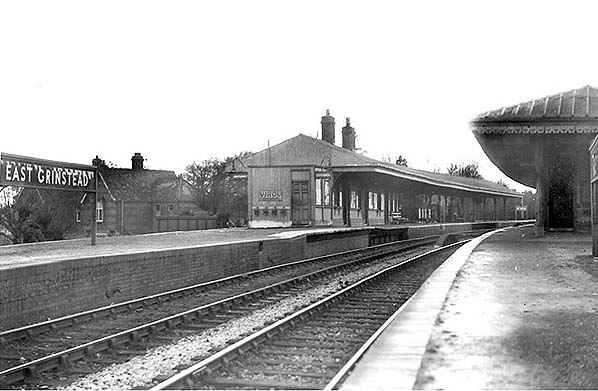
East Grinstead station looking west from platform 5 circa late 1950s. The station entrance building is seen on the left behind the running in board. This was the entrance for all platforms, East Grinstead being classed as one station with low and high level platforms.
Photo
from John Mann collection
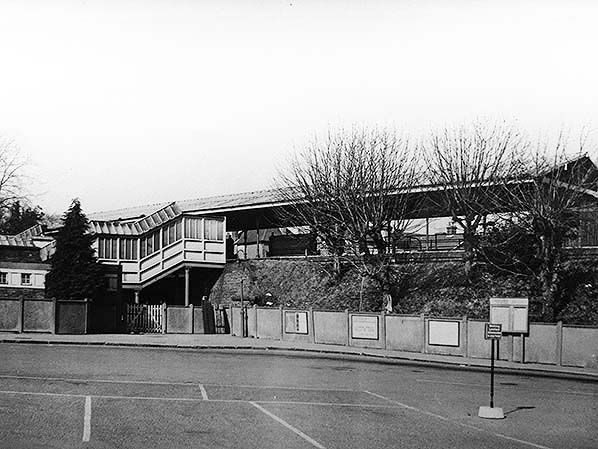 East Grinstead station forecourt in BR days. The station entrance is out of view to the left. The covered stairs led to the subway to the high level platforms 3/4.
Photo from John Mann collection 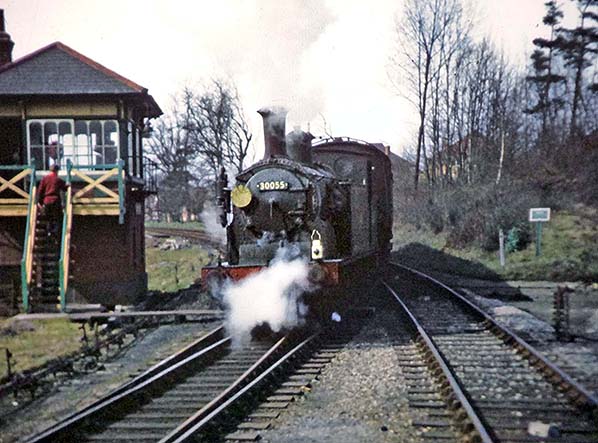 Ex LSWR Drummond Class M7 0-4-4T No. 30055 has departed from Platform 3 and is at the rear of a Push-Pull set bound for Three Bridges. Apart from the obvious, being taken in BR days, there is little visible which would help narrow down the date. The track branching off to the left beneath the locomotive was a siding. Between 1955 and withdrawal in 1963 No. 30055 spent time at both Three Bridges and Tunbridge Wells West sheds in between shuffling around between a few other sheds. She was to fall under the spotlight on 5 February 1955 when she operated the final passenger train over the Alton - Fareham (Meon Valley) line decorated with various adornments as was commonplace for such 'last train' occasions.
Photo from Lynne Cullen collection 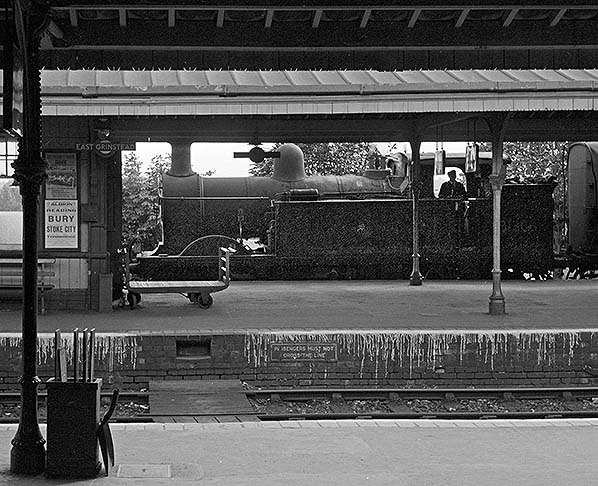
On 10 September 1961 Class H No. 31308 stands at Platform 3 with a crew member watching from the footplate. This locomotive would be withdrawn from Tunbridge Wells West shed on 23 December 1962. Photographs of this station taken beneath the canopies have proved to be uncommon and we are grateful for the detail on view in this example. Visible are two Southern Railway 'target' signs announcing the station name, with both illuminated by gas lights. Two platform number signs are suspended beneath the far canopy, for Platforms 3 and 4; these signs were only found beneath the canopies and near the subway entrances which was really all that was necessary. Similar signage would have been found in the subway, informing passengers which staircase they should ascend as well as signage directing passengers to Low Level Platforms 1 and 2. On the left are advertisements for Hove Greyhound Stadium (top) and for various Brighton & Hove Albion F. C. matches (bottom). Across the tracks is a staff crossing with footstep in the platform face along with a 'Passengers must not cross the line' warning. More usually these warnings went on to say 'Except by means of the footbridge [or subway as applicable]' but the Southern Railway obviously deemed the abridged wording adequate. At left foreground are a set of train destination indicator boards. These would be slotted into the device suspended at top left and set to point towards which ever platform was relevant. They were the forerunner of today's electronic departure indicators and can still be seen at certain heritage railways. This scene is generally neat and tidy, spoiled only by the whitewash running down the platform face from the edging.
Photo by Ian D Noble from his Flickr photostream 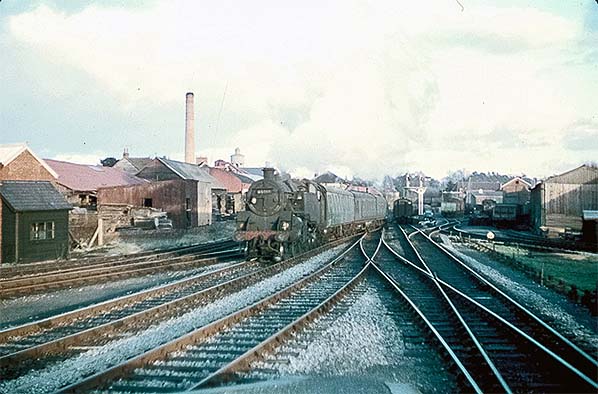
On 13 January 1962 a BR Standard 4MT 2-6-4T approaches from the Tunbridge Wells direction. The locomotive is thought to be No. 80015. Assuming so, she had been built at Brighton in 1951 and allocated from new to Tunbridge Wells West. She was destined to survive until the end of steam on the Southern Region on 9 July 1967, by that time allocated to Nine Elms. To the left and largely obscured from view by the train was a siding serving a timber yard while at centre right the siding which had connected to the East Grinstead Low Level - Culver Junction line can be seen branching off. The original terminus station was located in the right background.
Photo by John M. Cramp from 20937 transport Photograph Database 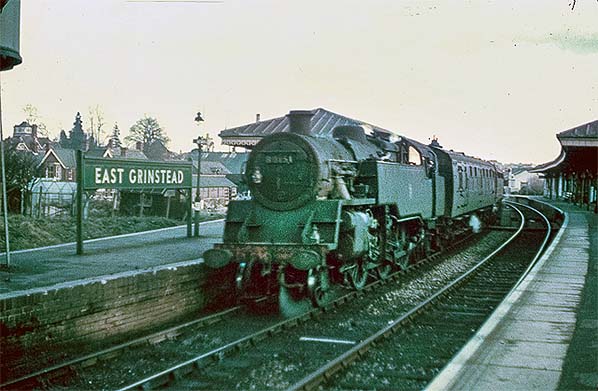 On 13 January 1962 BR Standard 4MT 2-6-4T No. 80151 arrives with a train from Tunbridge Wells West. This train will branch off at East Grinstead West Junction to take the St Margaret's Curve to Oxted and Victoria. Another Brighton-built example, No. 80151 was one the final batch and did not enter service until January 1957. Allocated to Brighton shed from new, she was still so-allocated when photographed and had probably worked up to Tunbridge Wells West via Hailsham and Eridge. She missed the end of steam on the Southern Region, being withdrawn on 7 May 1967 from Eastleigh shed, but is one of several class members to have survived into preservation. It is interesting to note that High Level was East Grinstead's main and busiest station, Low Level being something of an underused aside. This all changed when the Three Bridges - Tunbridge Wells West line closed in 1967 and all remaining traffic was concentrated at Low Level,
Photo by John M. Cramp from 20937 transport Photograph Database 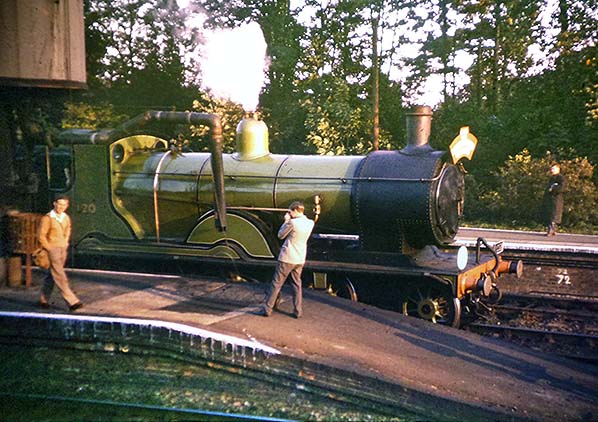 At 19:50 hrs on 24 June 1962 Class T9 4-4-0 BR No. 30120 waits at Platform 5. Two minutes later she will depart for London Bridge via Oxted and East Croydon. The occasion was the LCGB 'The Sussex Coast Limited' railtour which had set out from Waterloo and eventually reached East Grinstead from Eastbourne via Polegate and Heathfield (the so-called 'Cuckoo Line'). Between Eastbourne and Rotherfield & Mark Cross she double headed with Class M7 No. 30055, at which latter station the M7 was detached. No. 30120 is seen here restored to L&SWR livery as No. 120. Her history under British Railways followed an 'is she is she not withdrawn' pattern. Withdrawn, at least in theory, from Exmouth Junction shed on 18 March 1961 she was claimed for preservation by the National Railway Museum, moved to Eastleigh and given an overhaul including the repaint into L&SWR livery. This done she continued in service, working both railtours and ordinary service trains which meant, therefore, she was still in capital stock. Withdrawal from capital stock came in July 1963 but even then she continued to operate railtours until October of that year. She was the final member of the T9 Class to remain in service and is the sole example to survive in preservation. At 19:50 hrs on 24 June 1962 Class T9 4-4-0 BR No. 30120 waits at Platform 5. Two minutes later she will depart for London Bridge via Oxted and East Croydon. The occasion was the LCGB 'The Sussex Coast Limited' railtour which had set out from Waterloo and eventually reached East Grinstead from Eastbourne via Polegate and Heathfield (the so-called 'Cuckoo Line'). Between Eastbourne and Rotherfield & Mark Cross she double headed with Class M7 No. 30055, at which latter station the M7 was detached. No. 30120 is seen here restored to L&SWR livery as No. 120. Her history under British Railways followed an 'is she is she not withdrawn' pattern. Withdrawn, at least in theory, from Exmouth Junction shed on 18 March 1961 she was claimed for preservation by the National Railway Museum, moved to Eastleigh and given an overhaul including the repaint into L&SWR livery. This done she continued in service, working both railtours and ordinary service trains which meant, therefore, she was still in capital stock. Withdrawal from capital stock came in July 1963 but even then she continued to operate railtours until October of that year. She was the final member of the T9 Class to remain in service and is the sole example to survive in preservation.Photo from Lynne Cullen collection 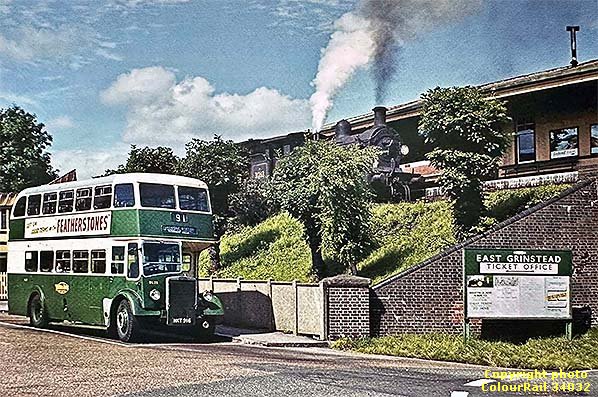
On an apparently pleasant day 19.8.1962 ex-SE&CR H Class 0-4-4T No. 31263 sits in the High Level station doing her best to annoy the photographer with her blowing-off safety valves. She has arrived with a train from Three Bridges. Withdrawn from Three Bridges on 5 January 1964, No. 31263 was purchased for preservation, initially in the hope of operating on the Westerham branch but this preservation scheme failed. She was then stored at various locations until arriving at the Bluebell Railway which of course means she can still be seen at East Grinstead today, albeit at the Bluebell Railway's platform near the former Low Level station, now known simply as 'East Grinstead'. Star of the show, with no offence to railway enthusiasts, is Leyland Titan PD2/12 fleet number DL23 of the Maidstone & District Motor Services. New in August 1951 she had a Leyland 55-seat Lowbridge body. Lowbridge bodies had a sunken side gangway in the upper deck and, usually, four aside bench seats. Lowbridge vehicles were jolly good fun for youngsters but to everybody else, not least conductors, they were an utter nuisance. Passengers sitting in the offside lower deck seats frequently banged their heads on the sunken gangway about their seats. No. DL23 is thought to have been withdrawn in 1965 but in 1962 was operating on service 91 to Tonbridge. The rather useless destination display, being very difficult to read from a distance, was typical of Maidstone & District vehicles. Up on the station is a British Railways advertisement for Ireland while at ground level the advertisement on the left promotes cheap tickets to Hove for the Brighton & Hove Albion F.C. By 1962, of course, it was necessary to travel via Three Bridges to reach Brighton or Hove.
Copyright photo from ColourRail
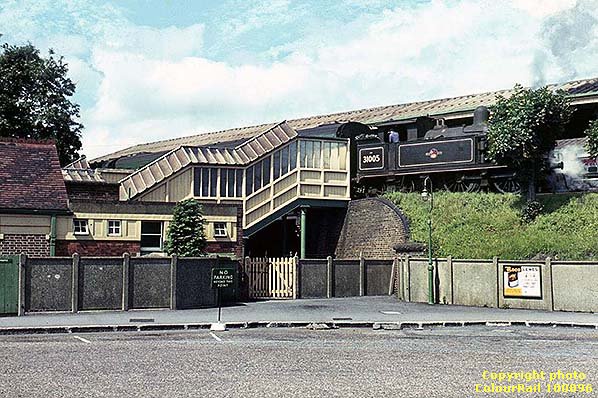 On 19 August 1962 reasonably clean H Class No. 31005 is caught by the camera with a Maunsell Push-Pull set. Modellers may appreciate this view for the detail of the Low Level station footbridge staircase. Also on view is some of the Southern's quite ghastly concrete walling. This was cast in sections at the Exmouth Junction Concrete Works and assembled as required on site. The advertisement board on the right advertises, on its left, 'Gloco', a form of refined coke sold as smokeless fuel and introduced sometime around 1959 - 1960. On the board's right is an advertisement for Lewes but other details are unreadable. Possibly it was advertising Lewes Racecourse, which dated from the 18th Century but closed down in 1964. Whatever the attraction was at Lewes in 1962, by that time it was no longer possible to travel by train directly from East Grinstead.
Copyright photo from ColourRail 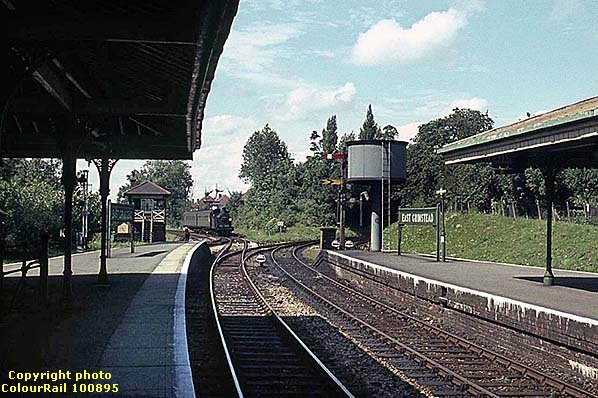
On 19 August 1962 Class H No. 31263 approaches from Three Bridges as the West 'box signalman waits to take the train staff from the footplate crew. As the signals in the background indicate, the route is set for the train to enter Platform 3 on the left. The line branching off to the right leads to St Margaret's Junction and the Oxted line. As the signalling and pointwork shows, there was a fair degree of operational flexibility. This station was always known as 'East Grinstead High Level' yet it will be noted the running-in boards, and for that matter the Southern 'target' signs, one of which can be seen to the right, did not display the 'High Level' suffix. The Low Level station name was also not given the relevant suffix. The reason, despite the 'High' and 'Low' designations, was it was for all intents and purposes a single station with high and low level platforms. 'Low Level' comprised Platforms 1 and 2 while 'High Level' comprised Platforms 3 to 6, the latter being from left to right in this view.
Copyright photo from ColourRail 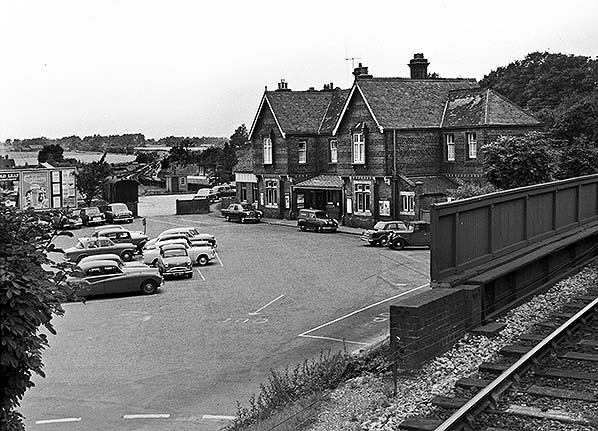
An elevated view across the forecourt from the High Level Platform 3 on 20th August 1962. Two of the motor cars, the Morris Oxford Series V (parked outside the station building) and the Ford Anglia 105E (parked behind the Standard 10 with PLL registration) were first introduced in 1959. Of the other vehicles present which can be identified are a Jaguar Mk VIII, a couple of Hillman Minx models, a Ford 100E, a Morris Oxford Series III, a Rover P4. Parked outside the station entrance is an Austin A30 van signwritten 'Courier'. This was probably the East Grinstead Courier newspaper. To its right is what looks like, going by the position of its badge, a Riley One-Point-Five. At far right is what appears to be an Austin 7 convertible. Among the unidentified vehicles are a number of older models from the 1940s. Car ownership at the time was very much an indication of status and what we see here is range of what we might call 'economy' vehicles such as the Standard, the Ford 100E and the suspected Austin 7 to the more upmarket Jaguar and Rover plus, at a pinch, the Riley. Some of these vehicles likely belonged to London commuters. In the background, left of centre, is the closed line to Horsted Keynes and Culver Junction crossing Imberhorne Viaduct. This line, apart from the Horsted Keynes - Sheffield Park section, was not lifted until 1963 but the section over the viaduct was retained for many more years to stable rolling stock. Beyond the viaduct is the cutting which was used for landfill before, many years later, being excavated for the Bluebell Railway. The line south to the viaduct was also still used, at the time of the photograph, for access to the dock at which a van is stabled. The connection to the goods yard, largely hidden from view, appears to be somewhat overgrown and out of use.
Photo by Ian D Noble from his Flickr photostream 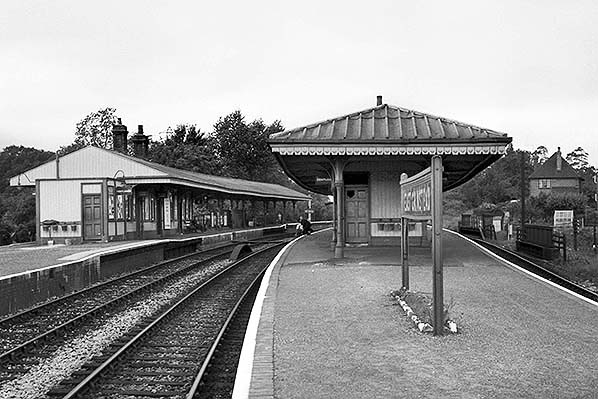 East Grinstead station looking west from platform 5 on 20 August 1962. The platforms are deserted apart for two people on the staff crossing - they are assumed to be railway personnel.
Photo by Ian D Noble from his Flickr photostream 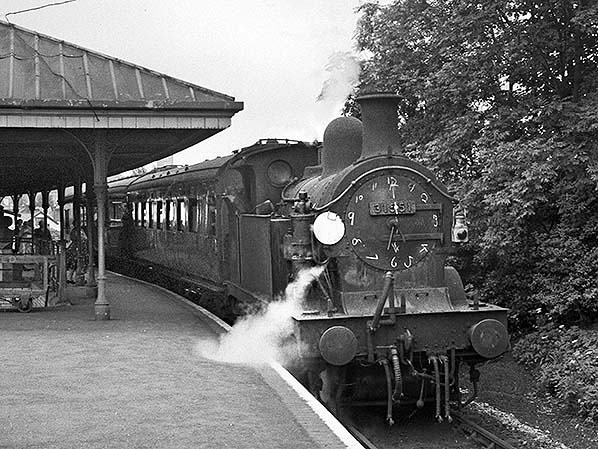
On 20 August 1962 Class H No. 31551 has arrived from Three Bridges with a Maunsell Push-Pull set. It will presumably continue to Tunbridge Wells West. The clock face on the locomotive's smokebox door must have been useful for letting people know the time as it scooted along the line. However, whether the time really was 16:32hrs as indicated by the 'darts' is another matter. What we can be sure of, though, is the 'darts' telling the correct time twice per day.
Photo by Ian D Noble from his Flickr photostream 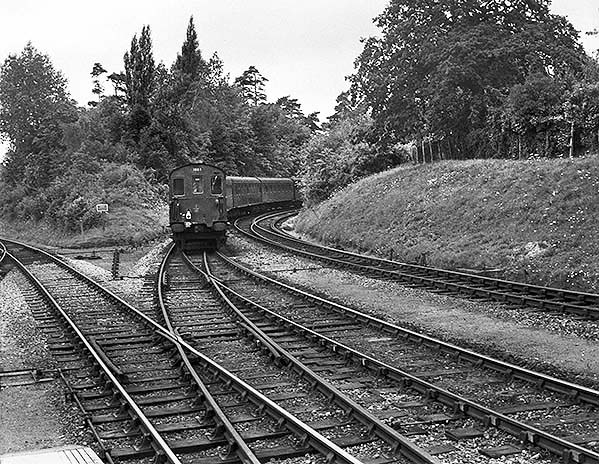
On 20 August 1962 Class 6S, later Class 201, 'Hastings' DEMU No. 1003 has just departed from Platform 5 and turns northwards towards Oxted. The photographer was standing on Platform 4 and as mentioned elsewhere the connection from this platform to the St Margaret's Curve was little used following the signalling alterations of 1958. In this view the condition of the rail heads makes this quite obvious. It seems, therefore, that Platforms 3 and 4 were the preserve of the local Tunbridge Wells - Three Bridges trains with Platforms 5 and 6 being for Oxted and London trains. DEMU No. 1003 was one the units built with narrow bodies due to restricted clearances on the then-non-electrified Hastings line but, as this photograph shows, they were by no means confined to the Charing Cross - Hastings line. No. 1003 was taken out of service in December 1964 as part of a plan to create the 3-car 'Tadpole' units which became Class 206. The story of these disbandments and reformations is far too complex to tell in an image caption but plenty of comprehensive information is available on line.
Photo by Ian D Noble from his Flickr photostream 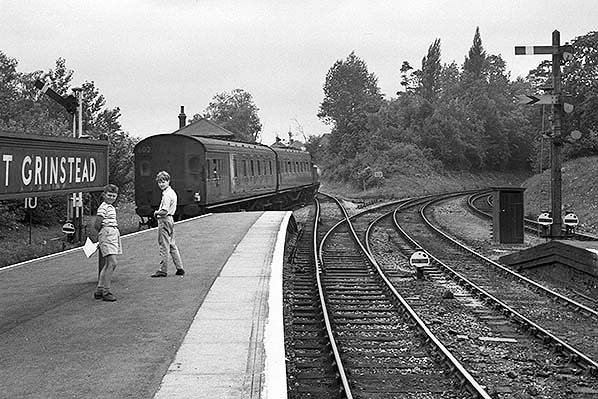
On 20 August 1962 Class H No. 31551 departs towards Three Bridges with Maunsell Push-Pull set No. 602 and will call at Grange Road and Rowfant along the way. Compared with the photograph of the Fairburn 2-6-4T a bracket signal is now in position just beyond what by now had become 'A' signal box. Strangely, perhaps, the rather ancient lower-quadrant signals on the right were never replaced although it does appear they had been moved a little further from the water tower just out of view to the right. The rails branching off onto St Margaret's Curve directly ahead of the camera do not seem to be seeing much use by this time and the points are controlled by the adjacent ground signal, one of several to the unmistakable Southern Railway style on view in this scene. One wonders if the two boys were the photographer's sons.
Photo by Ian D Noble from his Flickr photostream 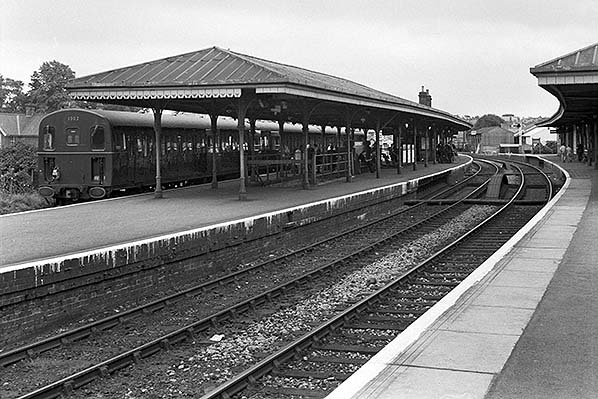 On 28 August 1962 the camera caught brand new DEMU No. 1302 which had just arrived from the Oxted direction. Originally classified as '3D East Sussex', later Class 207, these units were a restyled version of the earlier Class 2H and 3H 'Hampshire' units, later Class 205. Like many of these units No. 1302 went through various changes which included a period as a 2-car unit before becoming a 3-car again with the addition of an ex 4CEP EMU centre trailer. However, No. 1302 retained its original Driving Motor and Driving Trailer vehicles for its entire life which lasted until August 2004, by which time she was numbered 207203. She was to enter preservation, in 2-car form, but was to become the victim of an arson attack on 20 May 2016 which destroyed Driving Trailer No. S60901, the vehicle nearest the camera in this view.
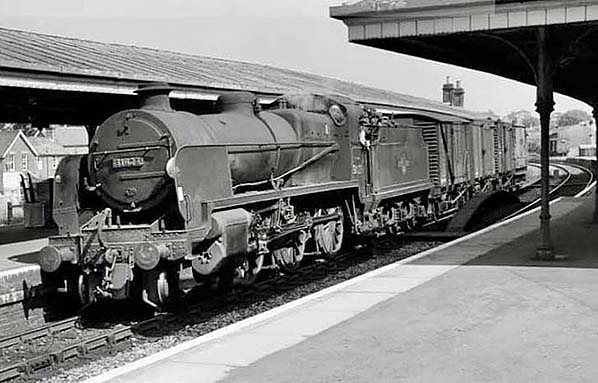 In 1962 a Maunsell N Class 2-6-0 was caught apparently stationary at Platform 5 with a short goods train. These locomotives had a couple of nicknames; 'Mongolipers' and 'Woolworths'. The origin of the first is unclear but the second originated from batch being assembled from kits of parts at Woolwich Arsenal. The locomotive in the photograph would appear to be No. 31823 but the final two digits are by no means clear. In 1962 a Maunsell N Class 2-6-0 was caught apparently stationary at Platform 5 with a short goods train. These locomotives had a couple of nicknames; 'Mongolipers' and 'Woolworths'. The origin of the first is unclear but the second originated from batch being assembled from kits of parts at Woolwich Arsenal. The locomotive in the photograph would appear to be No. 31823 but the final two digits are by no means clear.Photo from John Mann collection 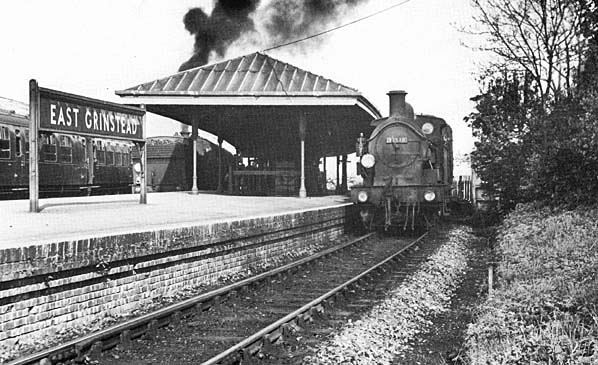
In May 1963 Class H 0-4-4T No. 31518, right, awaits departure for Three Bridges. At the opposite platform face the fire has just been stoked of what appears to be a Class M7 0-4-4T. It carries the disc headcode for Three Bridges - Tunbridge Wells but also has a tail lamp affixed to the bunker, suggesting it is coupled to a Push-Pull set the wrong way round to the conventional practice. At far left stands main line stock, probably one of the sets used on Victoria or London Bridge services.
Photo by J Gammell 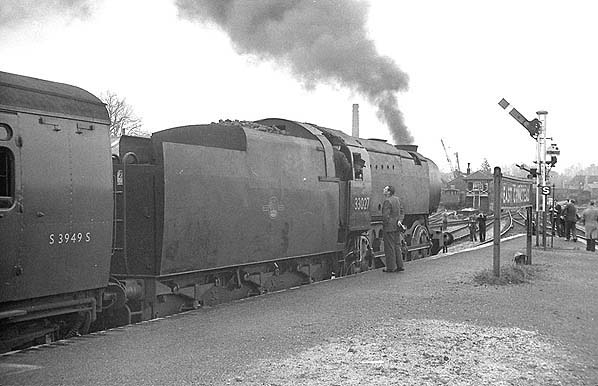 On 22 March 1964 'The Sussex Downsman' railtour waits at East Grinstead with Bulleid Q1 Class 0-6-0 No. 33027. The tour was from Waterloo to Victoria and covered many routes which are now closed. Several locomotives were used, with the Q1 working the Waterloo - Horsham and Three Bridges - Tunbridge Wells West sections. The Q1 Class was O. V. S. Bulleid's wartime austerity design, using the absolute minimum of materials and with features considered unnecessary, such as splashers, absent. Nevertheless it will be noticed efforts were made to match the profile of the tenders to that of Bulleid's coaching stock. The class was primarily intended for goods working but use on passenger trains, specials aside, was not unknown. Reputedly the most powerful 0-6-0 steam locomotive ever to operate in Britain, of the forty examples built one has survived into preservation. In the background of this view East Grinstead 'B' signal box, formerly East Grinstead East can be seen. With a Saxby & Farmer 43-lever frame it was the busier of High Levels two signal boxes.
Photo by Bevan Price 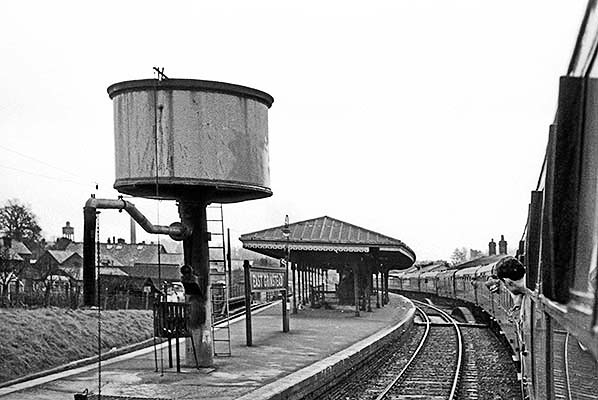 On 22 March 1964 'The Sussex Downsman' railtour pauses at Platform 4 on its way from Three Bridges to Tunbridge Wells West. The locomotive, out of view, was Bulleid Class Q1 No. 33027 and a photograph of this locomotive is seen above. The tour was a joint RCTS/LCGB event. At Tunbridge Wells West the Q1 would be detached and unrebuilt Bulleid Pacific No. 34066 'Spitfire' would be attached to the other end of the train, which would then proceed to Lewes and Brighton via Heathfield with another locomotive change at Pevensey. The coaching stock was 9-set No. 237. Southern coaching stock sets not infrequently were reformed, lengthened or shortened as requirements demanded. No. 237 had began life as a Maunsell 4-set but in 9-set from as seen here it was a mix of Bulleid and BR Mk 1 stock. The vehicles carried roofboards proclaiming 'THE SUSSEX DOWNSMAN RAIL TOUR'. One interesting carriage is present midway along the train and recognisable by its deeper side panels. It is a Bulleid catering vehicle and one of those rebuilt from a 'Tavern Car', another of Oliver Bulleid's strange, or perhaps to be more polite 'novel', ideas which he inflicted upon the travelling public. Later in this tour the train would visit the Kemp Town branch, behind yet another locomotive and this time an Ivatt 2-6-2T, but with set No. 237 temporarily reduced to seven vehicles. Note the brazier beside the water tower. These were lit during winter to prevent water columns and towers of the 'parachute' type seen here from freezing. To this end the braziers were usually, but not always, successful and much depended upon how often locomotives stopped to take on water.
Photo from John Mann collection 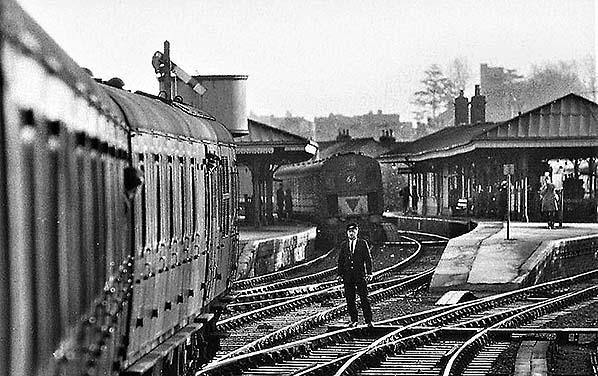
On what is assumed to be the final day of service a DEMU arrives at Platform 4 from Three Bridges, its guard about to hand the train staff to the signalman. The unit at Platform 5, displaying headcode 66, will depart for Victoria via Oxted.
Photo
from Jim Lake collection
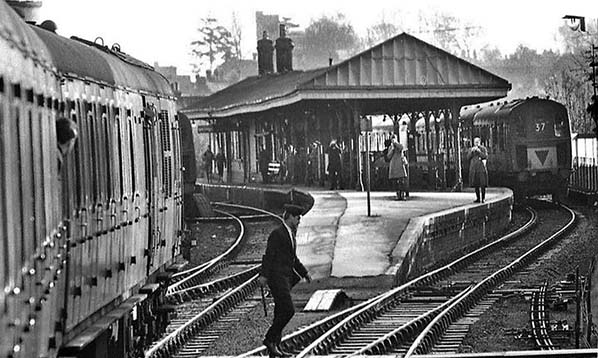
Another view of what is assumed to be the final day of service, with at least four DEMUs present as are a number of what are quite obviously railway enthusiasts. The unit at near left is arriving at Platform 4 from Three Bridges, its guard having just handed the train staff to the signalman of 'A' Box. He will return to his 'box, reset points and signals as required and then hand the staff to the driver or guard of the unit on the right which will depart for Three Bridges. The headcode '37' applied at this time to Tunbridge Wells West - Three Bridges and vice versa. Until 1963 it had also applied to Horsted Keynes - Haywards Heath - Seaford and after 1963 to Haywards Heath - Seaford. The code was also used for London Bridge - Reigate via Redhill, thus one code was used for several routes providing none shared the same tracks at any point en route. The same multi-use system applied to Southern disc/lamp headcodes.
Photo from Jim Lake collection 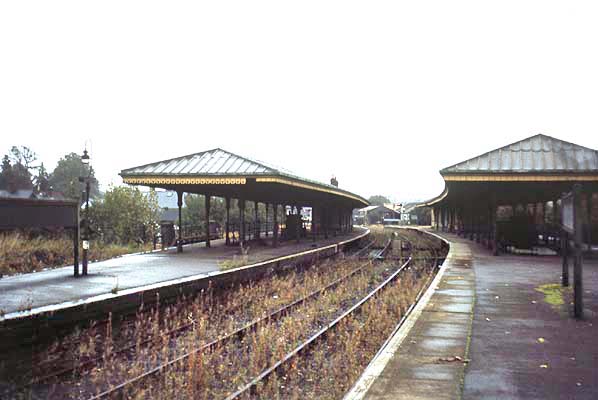
East Grinstead station looking east from platform 4 in November 1967, ten months after closure. The track bed is becoming overgrown with weeds. The top of the subway can be made out below the canopy.
Photo by Nick Catford 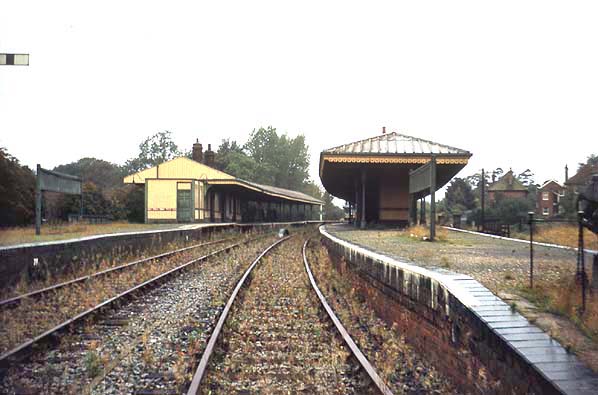 East Grinstead station looking west from the overgrown track bed in November 1967. Platforms are from left to right 3, 4, 5 and 6.
Photo by Nick Catford 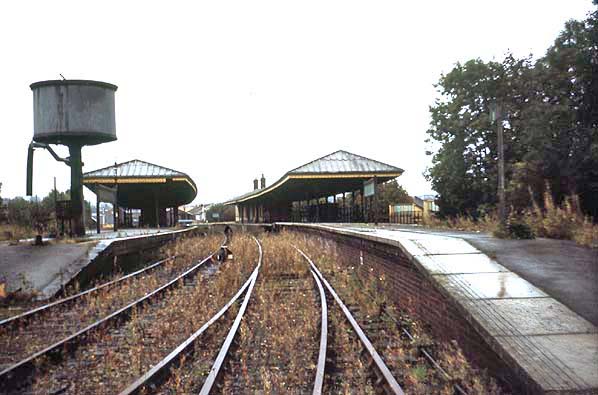
East Grinstead station looking east in November 1967. Ten months after closure apart from the removal of signs, little has changed. The top of the steps down to the entrance building and low level platforms 1 and 2 is seen on the right.
Photo
by Nick Catford
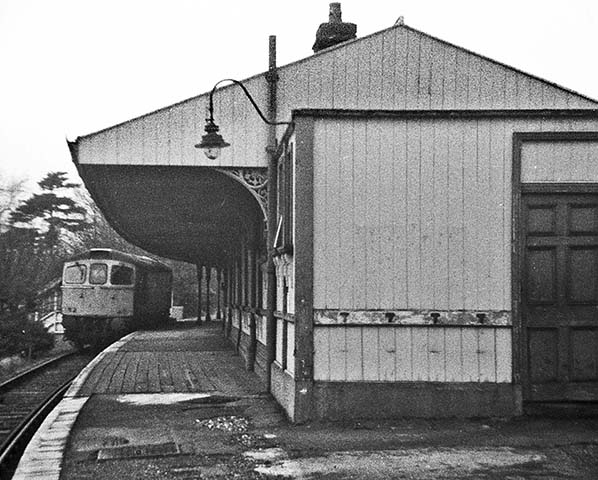 Sometime after closure a Class 33 diesel locomotive sits at Platform 3 with the Low Level footbridge visible to her left. She was likely involved with track lifting or some other form of material recovery operations. The period is most likely late 1967 - early 1968 as track remains through Platform 3 and that platform's building. Even a gas light survives intact; these were often among the first items to either vanish or be vandalised. By 1969 the final track through High Level was that through Platform 6, this being lifted later that year along with St Margaret's Curve and the line towards Three Bridges.
Photo by Chris Majer 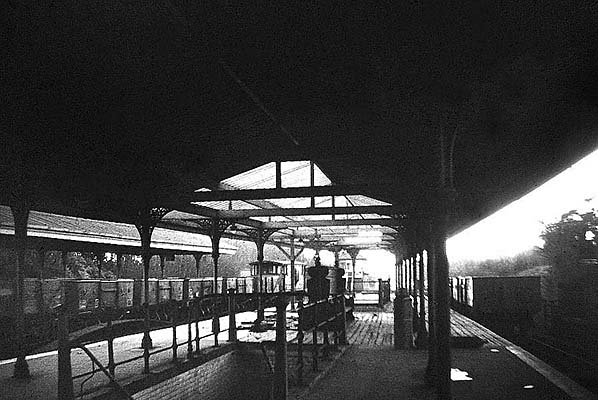
Wagons of the demolition train seen here in the station during 1968, with gas cylinders on the platform to the left. These trains were usually worked by Class 33 diesel locomotives, perhaps unsurprisingly given this was the Southern Region. The Ashurst Junction (Groombridge) to East Grinstead, including through the High Level platforms, section was dealt with first. The track onwards towards Grange Road and also St Margaret's Curve were left in situ a little longer with lifting of these beginning in the Autumn of 1969 and completed by the end of that year. The removal of the High Level platforms allowed Station Road bridge with its restricted, 13ft, headroom to be dealt with. This photograph offers a quite rare close-up view of one the subway entrances. The railed-in area beyond was where the High Level platforms crossed those at the Low Level.
Photo from Jim Lake collection 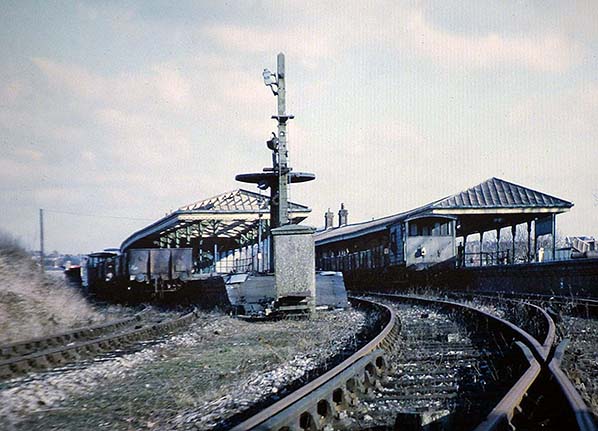
A further scene from 1968 showing demolition train wagons at Platforms 4 and 6. Whether this was two trains or one with a brake at each end but which had been divided is not known. Trains working over disused lines were restricted to a maximum speed of just 15MPH. The signal arms have been removed, apparently simply broken off as the lens frames are still present. The tank of the water tower has also been removed and what remained of the tower had been demolished by November 1968.
Photo from Lynne Cullen collection 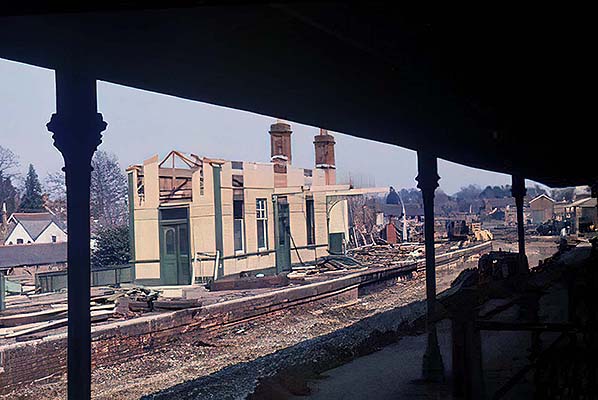 Looking east from platform 4 during demolition in 1968. Track has already been lifted through platforms 5 and 6 and the station building will soon be completely demolished while the start of demolition still awaits the buildings and canopy on platforms 4 and 5. The track to the east of the station was still in place at this time.
Photo by Brian Copsey 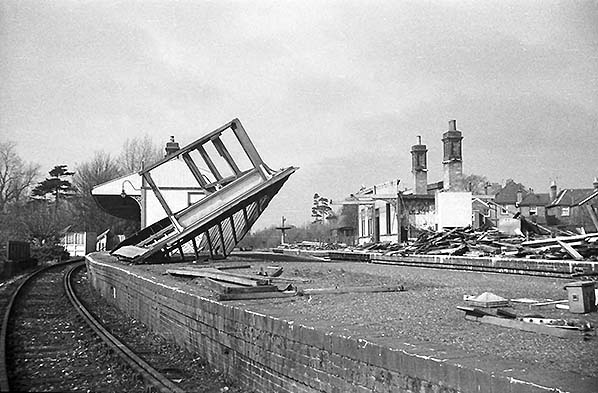
Demolition is underway at East Grinstead High Level in late 1968. The section of canopy on its roof has probably been moved there from platforms 5/6 as there is more room to break up the woodwork. Track is still in place through platform 3 and the brake van in the distance indicates there was still track there as well. Track lifting on towards Three Bridges and St Margaret's Curve didn't start till April 1969.
Photo by Brian Bennett from his Flickr photostream 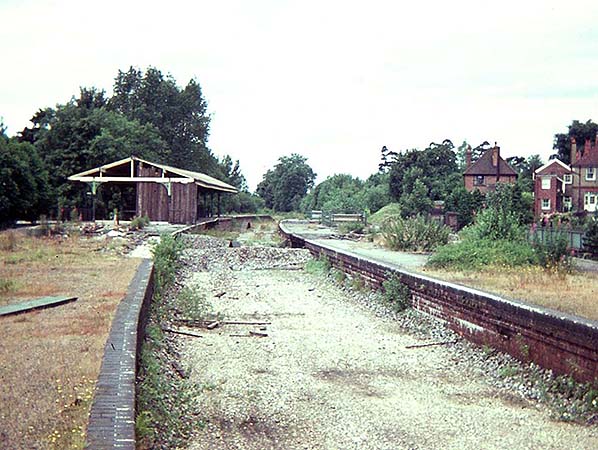
East Grinstead High Level station looking east circa November 1968. Platforms 5/6 have now had the buildings removed and all the timber seen in the picture above has been cleared away. The top of the subway can clearly be seen. Demolition of the platform 3/4 canopy is underway but work appears to have stopped.
Photo by Roger Goodrum from his Flickr photostream 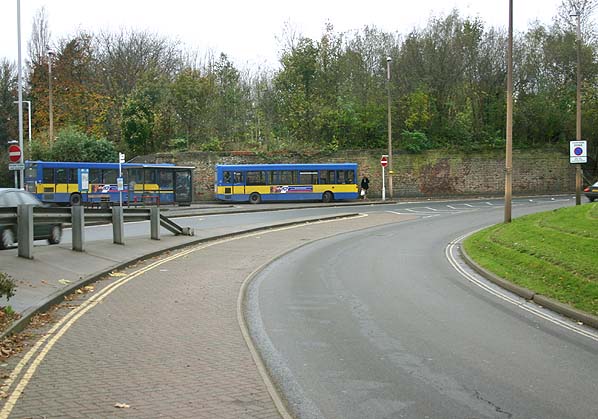
The site of East Grinstead High Level Station in November 2005. The station was carried over Station Road (where the buses are parked) on a wide bridge. One of the bridge abutments can still be seen behind the busses.
Photo by Nick Catford 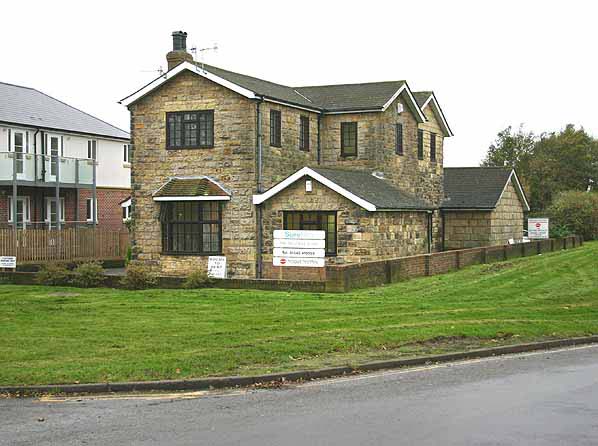 The 1855 station building and house at East Grinstead in November 2005. Compare this with the building shown in the 1860 photograph.
Photo by Nick Catford 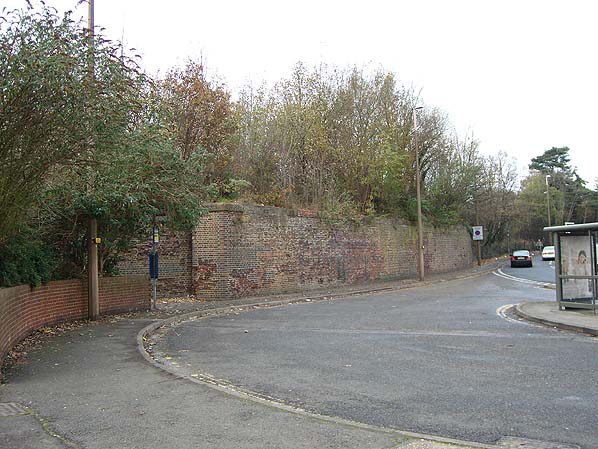
The site of East Grinstead High Level Station in December 2005. The
station was carried over Station Road on a wide bridge. One of the bridge
abutments is still extant.
Photo
by Dave Holman
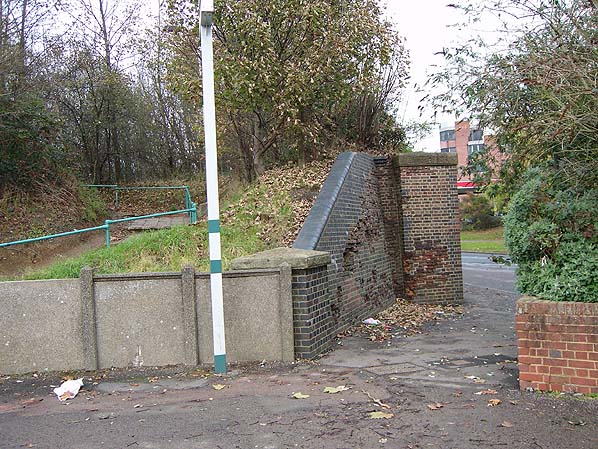
The site of East Grinstead High Level Station in December 2005. The station was carried over Station Road on a wide bridge. One of the bridge abutments is still extant - some brickwork from the platform can be found in the undergrowth on top of the bank. A section of the Southern Railway concrete wall is still in place.
Photo by Dave Holman  Home
Page Home
Page
|

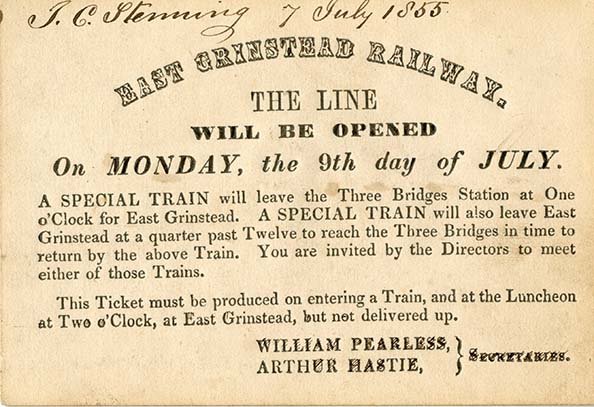
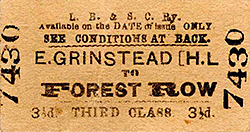 BRIEF HISTORY OF THE THREE
BRIDGES - TUNBRIDGE WELLS WEST RAILWAY
BRIEF HISTORY OF THE THREE
BRIDGES - TUNBRIDGE WELLS WEST RAILWAY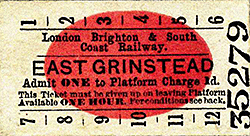 The EGG & TWR proposed to obtain powers to run over the BU & TWR line between Groombridge and Tunbridge Wells but before either line was opened the two companies were absorbed into the London Brighton & South Coast Railway in January 1865.
The EGG & TWR proposed to obtain powers to run over the BU & TWR line between Groombridge and Tunbridge Wells but before either line was opened the two companies were absorbed into the London Brighton & South Coast Railway in January 1865.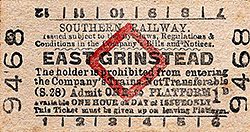 With the opening of the Lewes & East Grinstead Railway and the Croydon, Oxted and East Grinstead Railway in 1883 it was once again necessary to re-site East Grinstead Station. The two new lines approached the Three Bridges line at right angles from the north and south respectively. Because of the angle it was impossible to take the L & GR into the existing station so a new station was built a quarter of a mile to the west with two island platforms on the old line above and at right angles to a new station at the end on junction between the EGR and the CO & EGR with a sharply curving spur linking the two lines.
With the opening of the Lewes & East Grinstead Railway and the Croydon, Oxted and East Grinstead Railway in 1883 it was once again necessary to re-site East Grinstead Station. The two new lines approached the Three Bridges line at right angles from the north and south respectively. Because of the angle it was impossible to take the L & GR into the existing station so a new station was built a quarter of a mile to the west with two island platforms on the old line above and at right angles to a new station at the end on junction between the EGR and the CO & EGR with a sharply curving spur linking the two lines.
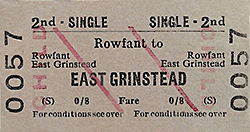 WW1 had little effect on the line and some new services were introduced following the formation of the Southern Railway in 1923. WW2 brought a reduction in services with the withdrawal of the rail motors. A government oil store was established at Rowfant bringing an increase in freight traffic. After the war some passenger services were reinstated but by 1950 both passenger and freight service were in decline and BR was considering the possible closure of the line between Three Bridges and Ashurst Junction in 1951 with passenger numbers at Hartfield in 1949 being only a quarter of those carried in 1923.
WW1 had little effect on the line and some new services were introduced following the formation of the Southern Railway in 1923. WW2 brought a reduction in services with the withdrawal of the rail motors. A government oil store was established at Rowfant bringing an increase in freight traffic. After the war some passenger services were reinstated but by 1950 both passenger and freight service were in decline and BR was considering the possible closure of the line between Three Bridges and Ashurst Junction in 1951 with passenger numbers at Hartfield in 1949 being only a quarter of those carried in 1923.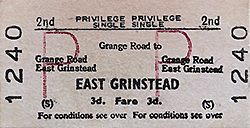 Despite strong local objections and a new timetable, Barbara Castle confirmed closure of the line between Three Bridges and Groombridge from 1st January 1967. Although originally proposed for closure the section between Groombridge and Tunbridge Wells West (West was added to the name in 1923) remained open.
Despite strong local objections and a new timetable, Barbara Castle confirmed closure of the line between Three Bridges and Groombridge from 1st January 1967. Although originally proposed for closure the section between Groombridge and Tunbridge Wells West (West was added to the name in 1923) remained open. 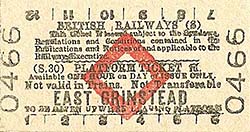 Shortly after closure the Tunbridge Wells and Eridge Railway Preservation Society was formed with an aim of reinstating the passenger service on the line. The Society acquired the line in the early 1990's and by winter 1996 they had refurbished half a mile of track and were able to run a steam service from their base on part of the old Tunbridge Wells West station site. TWERPS later merged with the North Downs Steam Railway at Dartford, Kent. The line is now known as
Shortly after closure the Tunbridge Wells and Eridge Railway Preservation Society was formed with an aim of reinstating the passenger service on the line. The Society acquired the line in the early 1990's and by winter 1996 they had refurbished half a mile of track and were able to run a steam service from their base on part of the old Tunbridge Wells West station site. TWERPS later merged with the North Downs Steam Railway at Dartford, Kent. The line is now known as 
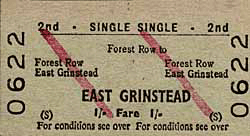
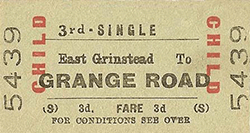
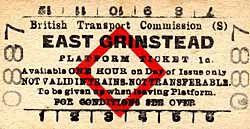
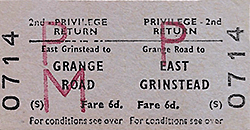
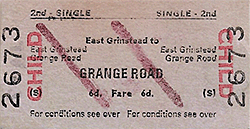
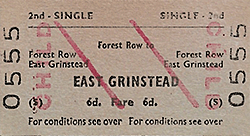
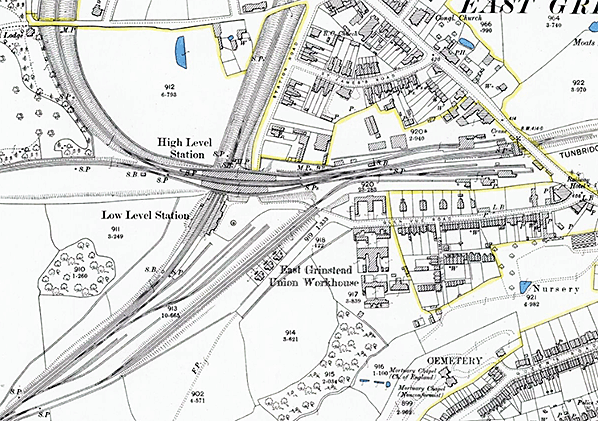
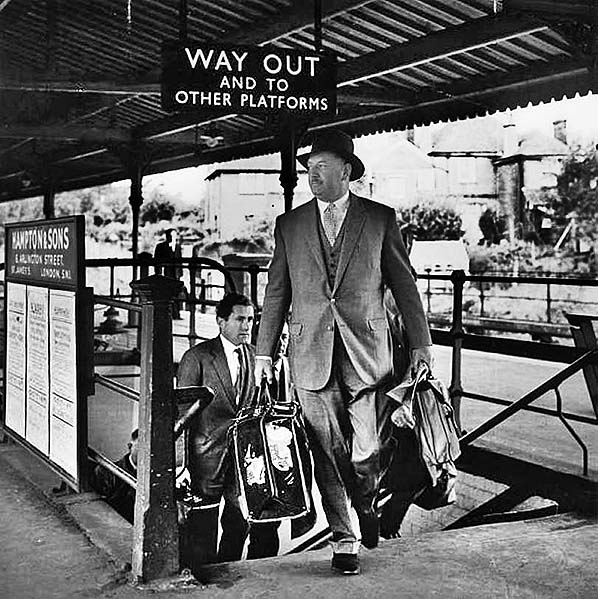 no means clear.
no means clear.